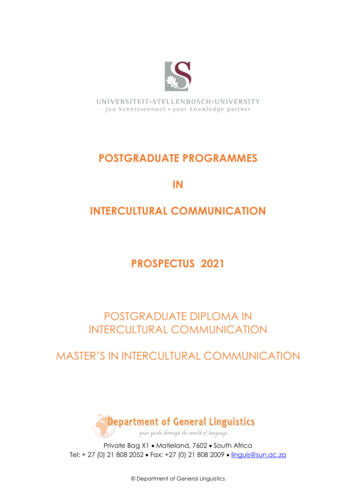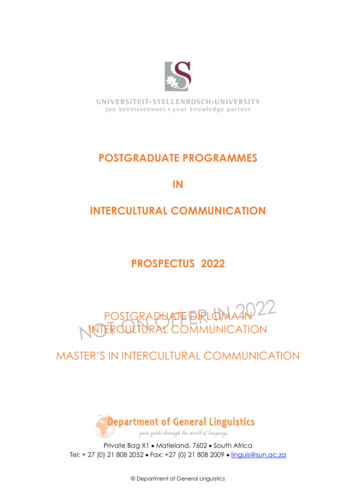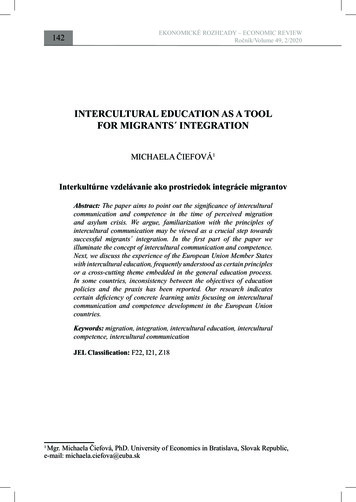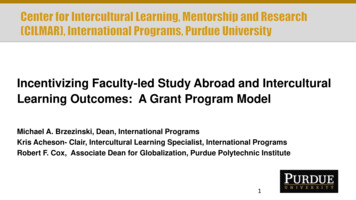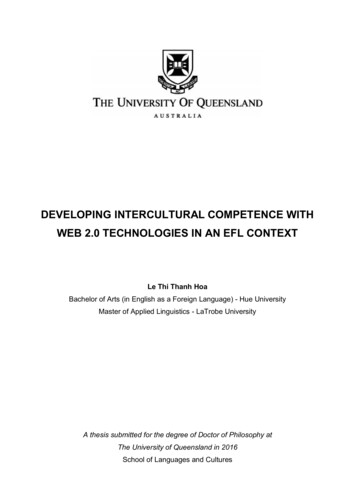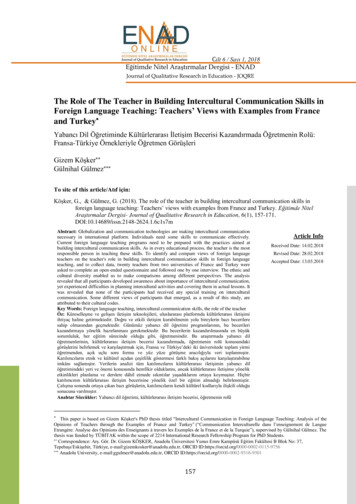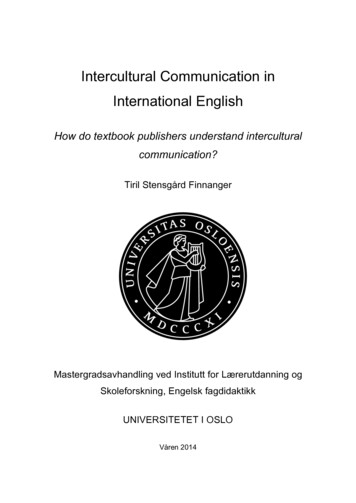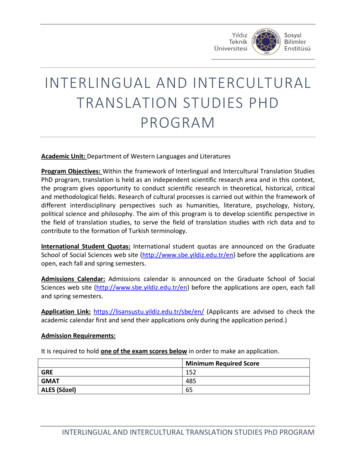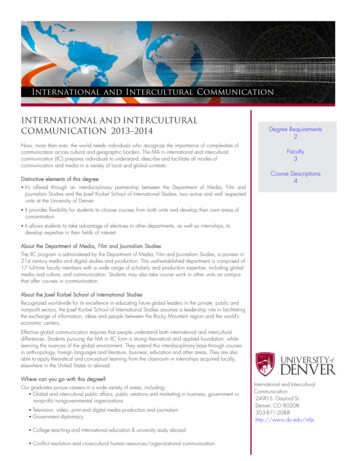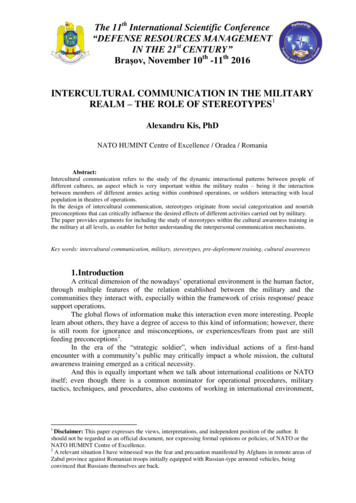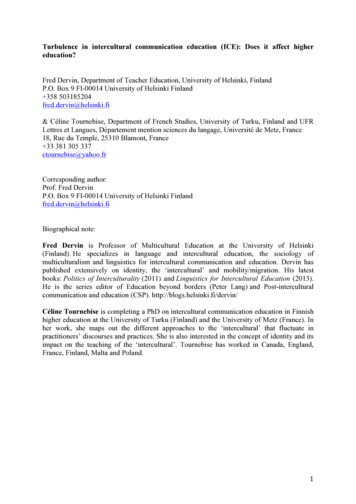
Transcription
Turbulence in intercultural communication education (ICE): Does it affect highereducation?Fred Dervin, Department of Teacher Education, University of Helsinki, FinlandP.O. Box 9 FI-00014 University of Helsinki Finland 358 503185204fred.dervin@helsinki.fi& Céline Tournebise, Department of French Studies, University of Turku, Finland and UFRLettres et Langues, Département mention sciences du langage, Université de Metz, France18, Rue du Temple, 25310 Blamont, France 33 381 305 337ctournebise@yahoo.frCorresponding author:Prof. Fred DervinP.O. Box 9 FI-00014 University of Helsinki Finlandfred.dervin@helsinki.fiBiographical note:Fred Dervin is Professor of Multicultural Education at the University of Helsinki(Finland). He specializes in language and intercultural education, the sociology ofmulticulturalism and linguistics for intercultural communication and education. Dervin haspublished extensively on identity, the ‘intercultural’ and mobility/migration. His latestbooks: Politics of Interculturality (2011) and Linguistics for Intercultural Education (2013).He is the series editor of Education beyond borders (Peter Lang) and Post-interculturalcommunication and education (CSP). http://blogs.helsinki.fi/dervin/Céline Tournebise is completing a PhD on intercultural communication education in Finnishhigher education at the University of Turku (Finland) and the University of Metz (France). Inher work, she maps out the different approaches to the ‘intercultural’ that fluctuate inpractitioners’ discourses and practices. She is also interested in the concept of identity and itsimpact on the teaching of the ‘intercultural’. Tournebise has worked in Canada, England,France, Finland, Malta and Poland.1
Turbulence in intercultural communication education (ICE): Does it affect highereducation?Fred Dervin, University of Helsinki, Finland & Céline Tournebise, University of Turku,Finland and Université de Metz, France.Abstract: This article examines a rather neglected context of intercultural education:intercultural communication education (ICE). ICE can be found in different fields such asbusiness, applied linguistics, intercultural communication and health education, amongst others.The authors start by reviewing the latest and ongoing changes (‘turbulences’) in the way the‘intercultural’ is conceptualized in this field and form a template for analysing a focus groupwith lecturers of intercultural communication in the Nordic country of Finland. The article isexploratory and does not claim to deal with intercultural communication education as a whole inthis context. Our analysis shows that these practitioners, who are also researchers specialised inintercultural communication, share discourses about the importance of the ‘intercultural’ ineducation but at the same time they are unable to clearly position themselves in its polysemicdefinitions and approaches. The current turbulences seem to have very little coherent impact onthe way they talk about the ‘intercultural’.Résumé: Cet article se penche sur un point quelque peu négligé de l’enseignementinterculturel, soit l’enseignement de la communication interculturelle (ECI). On retrouve l’ECIdans de nombreux domaines comme les affaires, la linguistique appliquée, la communicationinterculturelle et l’éducation à la santé, entre autres. Nous allons passer en revue les dernierschangements en cours (« turbulences ») dans la façon dont l’interculturel est conceptualisé dansce domaine et dégager un modèle qui nous permettra d’analyser un groupe centré constituéd’enseignants de communication interculturelle en Finlande, pays du nord de l’Europe. Cetarticle est exploratoire et ne prétend pas traiter l’enseignement de la communicationinterculturelle dans son ensemble dans ce contexte, mais il entend montrer que ces praticiens,qui sont également des chercheurs spécialisés dans la communication interculturelle, partagentdes discours sur l’importance de l’interculturel dans l’enseignement sans parvenir dans le mêmetemps à se positionner clairement dans ses définitions polysémiques et ses différentes approches.Les turbulences actuelles semblent avoir un minimum d’impact cohérent sur la façon dont ilstraitent l’interculturel.Keywords: Finnish higher education; intercultural communication education; renewedinterculturality; internationalisation; business studies.Word count: 5873 words2
INTRODUCTIONIntercultural communication education (ICE) is not a new field. Its history officiallydates back to the 1950s and the birth of the field of intercultural communication in the USA(Martin et al. 2011). With the accelerated globalization of the last decades, ICE has boomed(Jackson 2011). The field as such is not unitary but complex as it is represented by ‘multiplestrands of research’ and practice worldwide (Martin et al. ibid.). It is found in such contexts asapplied linguistics, language education, business, health education but also the field ofintercultural communication itself. It is easy to presume, based on this inexhaustible list ofdomains, that approaches to intercultural encounters are many and varied in both research andteaching (Martin et al. ibid.). Besides, critical voices have shown recently that the‘intercultural’ can be perceived and defined by researchers and practitioners alike in manydifferent ways, even within the same field. It is thus impossible to give a clear-cut overviewof all these approaches. Our intention is to note some of the recent major critiques that havebeen made by various scholars in relation to ICE. These critiques concern, amongst others,theories and methodologies and represent what we shall refer to as ‘turbulences’ in the field(Kumaravadivelu 2008; Fougère and Moulette 2009; Holliday 2010; Piller 2011; Dervin2012). Our use of the word ‘turbulence’ is directly inspired by the title of a conferenceorganised by the Nordic Network for Intercultural Communication at the University ofHelsinki in 2011, Theoretical Turbulence - A paradigm shift in the field of interculturalcommunication? The objective of this interdisciplinary conference was to examine the currentchanges in the way the ‘intercultural’ is researched.The main goal of this article is to observe the potential presence and impact of suchemerging changes, criticisms and turbulences in the work of teachers of interculturalcommunication in the European and Nordic country of Finland. The article is exploratory inthe sense that (1) these changes are still on-going and far from being stable and (2) it is basedon a case study and does not claim to apply to intercultural communication education as awhole in the context under scrutiny.Finland has been experiencing increasing internationalization in recent years, duemostly to her excellent results in international educational rankings such as the Programmefor International Student Assessment (PISA). In order to accommodate for the thousands ofexchange and international students in Finnish higher education, many courses andprogrammes are devoted to the ‘intercultural’. Yet, very little is known of these courses, theirobjectives and how the intercultural is conceptualized by course leaders and teachers (Dervinand Tournebise 2012; Dervin & Layne, 2013; Tournebise forthcoming)1.This article represents a first exploration of ICE in this context. It is based on theanalysis of a focus group with three teachers of intercultural communication working inFinland. We are interested in how the teachers conceptualize, construct and negotiate the‘intercultural’ when they talk about what they teach and how. Focus groups allow examiningin details how such constructions occur and noting multifaceted perspectives on a specificobject of discourse (Marková et al. 2005). It is our assumption that the current turbulencesthat we have identified in ICE can be uncovered in what university educators in Finland haveto say about their work as they are required by their employers to play an active role in globalresearch worlds (Cai and Kivistö 2011).1The data analyzed in this article are part of a PhD research project: Tournebise, C. L’enseignement dela communication interculturelle en Finlande : quels liens avec les identités des enseignants ?(supervisors: Fred Dervin and Guy Achard-Bayle).3
1. A template to analyse the presence and impact of current turbulences in ICEAs asserted in the introduction, new ways of working on ICE are now appearing inresearch and practice. These often critical approaches represent reactions against classicapproaches to interculturality provided by influential figures such as E.T. Hall, Trompenaars,Hampden-Turner and Hofstede, which Holliday calls the ‘Hofstedian legacy’ (Holliday 2010,6; McSweeney 2002). These approaches tend to rely on the accumulation of knowledge aboutdifferent cultures, often used synonymously with knowledge about ‘nations’. They often leadto stereotypes or simple categorizations, rather than attempting to reflect the complexity ofintercultural actors and situations (McSweeney 2002).In what follows we review six of the most important ‘turbulences’ that have beenproposed to renew the notion of the ‘intercultural’ in ICE in recent years. This will serve as atemplate to analyse the data derived from the focus group under scrutiny. Due to limited spacewe can only touch on some basic elements of each define turbulence. The reader might referto Dervin (2012), Dervin and Tournebise (2012) and Tournebise (forth.) for more detailedexplanation.Turbulence n 1: Putting an end to differentialist biasesThe first change that was noticed in the way the ‘intercultural’ is worked upon in ICErepresents a call to put an end to differentialist biases, a common vision in ICE which focusesexclusively on differences, especially in relation to the ‘tired’ and generalizing concept ofculture (Abdallah-Pretceille 1986). One such bias is the dichotomization betweenindividualistic and collectivistic ‘cultures’, which is often used to ‘explain’ encountersbetween people from the ‘West’ and ‘East’ or ‘North’ and ‘South’. Holliday (2010) hasanalysed forcefully the ethnocentrism and moralistic judgments that such differentialism cantrigger. The risk in continuing using these elements in such a loose and acontextualized way isthat they can lead ‘easily and sometimes innocently to the reduction of the foreign Other asculturally deficient’ (Holliday 2010, ix).Turbulence n 2: Moving away from individualist biasesAnother aspect, which is being increasingly put into question, is what we callindividualist biases. Discourses on the self and the other – identity constructions – are alwaysco-constructed between people. An identity is created and exists because there is anotheridentity that can be compared or opposed to it (Bauman 2004). Therefore, when interculturalactors, but also researchers and practitioners, work on the ‘intercultural’, their stereotypes,representations and ideologies inform and influence encounters and thus identities (Holliday2010, 2; Dervin 2012). That is why it is important for e.g. researchers to be aware of theirown ideologies when they analyse intercultural data, clarify their own positions and take theminto account when analysing data.Turbulence n 3: Exhausting results is impossibleThe idea that not everything can be explained as far as the ‘intercultural’ is concernedand thus that it is often impossible to exhaust results when researching it, has not gained muchground in ICE yet. However, many phenomena that we examine or teach about derive fromthe playful, the imaginary and the dreamy and cannot thus always be explained (Maffesoli1985). For Holliday (2010, 27), this means that we need to put aside established descriptions,to seek a broader picture, to look for the hidden and the unexpressed in interculturalencounters.4
Turbulence n 4: Looking at exceptions, instabilities and processes rather than merestructuresA lot of work on ICE has concentrated on structures and on describing how a certaingroup of people (usually determined by ‘nationality’ or ‘ethnicity’) communicates withanother (Piller 2011) – leading to the equation ‘the more you know about their habits,thoughts, etc. the more able you are to “control” them and thus interact in a proper andunproblematic way’. Many scholars argue that this does not reflect the current ‘mélange’(Pieterse 2004; Wikan 2002) and urge researchers and practitioners to look instead atexceptions, instabilities and processes, which are ‘natural’ parts of sociality (cf. Baumann1988; Bensa 2010).Turbulence n 5: Taking into account the importance of intersectionalityThe idea of intersectionality, ‘the interaction of multiple identities and experiences ofexclusion and subordination’ (Davis 2008) is also thought-provoking for ICE. It is alreadyvery much common practice in the field of intercultural education, influenced highly bycritical multicultural education (Banks and McGee Banks 2009; Sleeter 1996). Interculturaleducationalists argue that it is not just ‘culture’ that guides interactions but the coconstruction of various identities such as gender, age, profession, social class, etc. All theseintersect in intercultural interaction and thus need to be taken into account (Sleeter ibid.).Turbulence n 6: Placing Justice at the center of intercultural communication educationThe final turbulence in ICE that we would like to put forward is that of justice: ‘acommitment to combat inequality, racism as well as sexism, and all other forms of prejudice,oppression and discrimination through the development of understanding, attitudes and socialaction skills’ (Räsänen 2009, 37). Though, again, this is far from new in e.g. the field ofIntercultural Education, progress is needed in ICE. A few examples have been identified inthe literature: For example, in his critical cosmopolitan paradigm, Holliday (2011, 48)suggests increasing the awareness of institutional and cultural racism and power structures inthe world in ICE. He justifies this approach by arguing, rightly, that (ibid.): ‘inequality islargely denied in the dominant approach to intercultural communication studies’.The six turbulences presented here are not accepted by all scholars and practitioners inICE (Holliday 2010; Dervin 2012). Nevertheless they appear to be playing an increasinglyimportant role in the literature. As these turbulences are ongoing, they tend to be combinedwith aspects of the classic approaches to the intercultural (‘the Hofstedian Legacy’), whichleads to ‘clashes’ of ideas, methods and approaches (Abdallah-Pretceille 1986; Aikman 2012;Dervin 2011). In the following sections, we argue that, as specialists of ICE, the teachersunder scrutiny most probably undergo both the turbulences and these ‘clashes’. Working on afocus group, where the teachers need to negotiate meaning (Marková et al. 2005), will thusallow us to identify if and how they take on the turbulences when sharing their experiences onICE.2. About the dataThe data analysed here were obtained through a focus group collected in Finnishuniversities in 2011. A call was sent to recruit participants on different mailing lists related to5
questions of interculturality, internationalization and education in Finland. The threeparticipants of the focus group under scrutiny are all Finnish and work at major ‘Schools ofEconomics’ (lecturers (1), (2) and (3) in the transcriptions). They all specialize in Businessand/or Management and teach intercultural communication – which some of them call multi-/or cross-cultural during the focus group, without differentiating these terms. They all haveexperience of international mobility and speak at least three languages (Finnish English Spanish/Swedish). Lecturer (1) does not teach intercultural communication as a main subjectbut includes it in all her classes; Lecturer (2) teaches intercultural communication as a mainsubject occasionally, during seminars and/or workshops; Lecturer (3) teaches interculturalcommunication as a main subject on a regular basis. They all work with both Finnish studentsand international/exchange students. Only one of the lecturers has received formal educationand training on intercultural communication at a Finnish University and has attended lecturesand seminars by ‘classic’ interculturalists such as Milton Bennett and Fons Trompenaars.They have all written articles and given scientific presentations on the topic, ‘at home’ andabroad. In what follows, we are not describing what the teachers do but how they talk aboutthe ‘intercultural’ as a practice in teaching and research. A future study will attempt toconfront the latter with class observations.During the focus group, which lasted approximately 1 hour, the participants wereprovided with a short list of questions to stimulate the discussion (e.g.: What do you teach inrelation to the ‘intercultural’? How do you teach it? What has influenced you most in the wayyou understand the ‘intercultural’?). The discussion took place in English, was recorded witha voice recorder and transcribed orthographically. In their book Dialogue in Focus Groups,which also suggests a co-constructionist approach to discourses, Marková et al. (2005)recommend to give minimum guidance to the group and not to sit with the participants toallow them to feel less pressure during the conversation. We followed this piece of advice andleft the teachers work together in a room.3. Constructing intercultural communication education in Finnish higher education: alook at the turbulences in practice?The following sub-sections are based on an analysis of the lecturers’ discourses on the‘intercultural’ during the focus group. Bearing in mind the 6 turbulences presented above, weread through the transcription of the focus group several times in order to determine theirpotential presence in the discourses they co-constructed. Our analysis of the transcripts isdivided into 4 themes, each of which we review in more detail. The first step in the analysis(3.1.) was to interrogate if and how the lecturers defined the ‘intercultural’ and if generalsigns of the turbulences were present in the definitions. We believe that people’sunderstanding of the notion should always be probed as it is polysemic (see 1.). The threeother subsections examine three of the six turbulences that were identified in the focus group(turbulences 3, 4 and 5).3.1. Multifaceted and contradictory discourses on the ‘intercultural’In this section, we want to find out how the three Finnish teachers of interculturalcommunication conceptualize and construct the ‘intercultural’. In so doing, we are alsointerested in if and how the participants take into account renewed interculturality, i.e. theturbulences that compose our template.A first noteworthy aspect of the focus group is the fact that the notion of theintercultural seems to be shared by the group yet none of the participants clearly explains howthey understand it. Neither do they provide any definition. A closer look at what the lecturers6
have to say about the ‘intercultural’ shows that they do not necessarily perceive it the sameway and that their conceptions differ in terms of how they relate to the turbulences.In general it is impossible to categorize each lecturer in a specific box in relation tohow they negotiate the intercultural. It appears that Lecturers 1’s and 2’s discourses seem tobe more ‘classic’ than Lecturer 3’s at times. However, we can find traces of both ‘classic’ andrenewed interculturality in all of the three lecturers’ discourses, with a potential preference forits classic form.In order to show how unstable discourses on ICE (Abdallah-Pretceille 2006) are in thefocus group, we look at the following dialogue. The notion of arrogance comes back severaltimes in the focus group, especially in relation to how some people treat others in interculturalencounters. ‘Removing’ this arrogance appears to be a common learning goal amongst thelecturers. In the middle of the focus group, Lecturer 2 starts a discussion on how arrogant‘Western’ people can be. Yet, with the help of Lecturer 3, she co-constructs a critique of the‘human’ in general – not just the West:(2)Western people think they have the best everything, we have the best culture, youknow, so wherever people go they’re not humble to get into humble in the contextwith the other culture but they look down(3)but that’s that’s an old um (2) problem(3)imperial problem whoever is the big power, the superpower in the world makesthe rules and think think that we are the best, we are the most (2)yes that’s probably human actually(3)yes and others are just ridiculousLecturer 1 then suggests that the Chinese themselves are ‘a bit arrogant’:(1)don’t you find that the Chinese are a little bit arrogant foreigners also?(2)yeah yeah that’s why I’m saying that it’s human probablyLecturer 2 goes back to her point as a response to this ‘attack’: arrogance is human, not justeastern or western. But neither Lecturer 1 nor Lecturer 3 follows her on that point. Lecturer 3uses very general and stereotypical representations on the Chinese and the French:(3)because well if you study those what people think, they are sort stereotypesvalues so I’ve studied that the Chinese even if they are so modest and so humble insometime in communication, they still think that China is absolutely the center of theworld and they have the best everything they’ve discovered everything and theydon’t even need to know anything else because China is best in Europe itespecially very much used to be the French attitude, French culture is superiorAs asserted previously, Lecturer 3’s discourse on the ‘intercultural’ seems to showmany pieces of evidence of renewed interculturality during the entire focus group. Howeverthe previous excerpt contains a clear ‘classic’ and limiting argument (‘they (the Chinese) aremodest and humble’). She even transfers the case to Europe, and compares it with what shecalls ‘the French attitude’ in the past. Lecturer 2 (who attempted to be critical in the previousexcerpts), agrees with her and adds that the UK is another arrogant nation:(2)and UK(3)and they say so aloud as well Chinese don’t say so aloud in real normalconversations but they think7
Interestingly, the discussion around arrogance is ended by Lecturer 1 who suggeststhat such arrogance can also be found ‘locally’. She gives the example of the Finnish city ofTurku2, which she qualifies as such:(1)but I suppose it dies hard Turku still thinks that they’re this they are the capital ofFinland in some waysThis first section has shown that the ‘intercultural’ is an unstable notion for the threeuniversity educators who took part in the focus group. Some of the turbulences presented inthe proposed template were identifiable in their discourses (commonalities versus differencesin ethnocentrism; the local versus the international, etc.). In what follows, we focus morespecifically on some of the turbulences negotiated by the research participants.3.2. Referring to instabilities and exceptions in ICE?The idea that the intercultural is not about structures but processes (instabilities andexceptions) was identifiable in one lecturer’s discourse, Lecturer 2, who teaches interculturalcommunication as a main subject occasionally and specialises in Chinese ‘culture’. Herdiscourse on ICE appears quite differentialist at the outset:I’ve focused in these differences in visual cultures and intercultural communicationobviously due to my research so I’ve been talking and showing the differences ofhow how in different cultures you use different visualities to communicatesomething The words ‘differences’ and ‘different’ are uttered four times in this short excerpt,which shows that she concentrates on the diverging points rather than studying similarities orinstabilities ‘within’ and between ‘cultures’. She justifies – to a lesser degree –her approach tothe intercultural by mentioning her personal experience which has led her to think that way:I’ve always been interested in cultures and people I’ve travelled a lot alone um whenI was single I just flew somewhere and went off so that’s one way to to get moreinside the culture if you’re travelling alone and you know try to really meet localpeople In her own words: travelling allows her to be ‘more inside the culture’ and ‘reallymeet local people’. The latter is a classic assertion in ICE: when abroad, only the ‘other’, theforeigner should be met so that we can learn about their ‘culture’ (Abdallah-Pretceille 1986;Dervin 2011).Regardless of these canonical and problematic views on the intercultural, someelements of renewed interculturality are noticeable in her discourse. For example, in thefollowing excerpt, she asserts that it is impossible to rely merely on structures (‘cultural lists’)and that contexts should be taken into account:my goal when I started my PhD project was to help Finnish industry in selling intoChina and I was hoping to find these easy business rules on how to use colors andhow not to use colors like to do and not to do lists and so I found out that it’simpossible to do so, you have to understand why and why in particular context somecolor means this and in another context it means something completely different2Turku used to be the capital of Finland before the capital was moved to Helsinki in the 19th century.8
In a sense, she seems to suggest that ‘cultural’ elements are unstable and contextdependent. However, in the following utterance, she contradicts herself by mentioning one ofthe ‘don’t’ points that she tries to avoid. Her Chinese students are used to confirm herargument:luckily I had I have had some Chinese students in the class as well so they confirmedmy findings because they some of them sound really ridiculous from the Finnishpoint of view, like there is this which is mostly people think it’s just humorous,the meaning of the green hat in china which is that if a husband wears a green hat itmeans his wife is betraying him and um for many Finns it sounds you know theystart laughing ( ) but for the Chinese it’s very serious and very insulting, so if youwould give out a green colored hat for example as a business gift it’s and it’s oneof this easy don’t do this thing but also um also it is a brilliant exampleThe turbulence of instabilities and exceptions seem to disappear in this anecdote. Assuch, by using representatives of the ‘culture’ in question (Chinese students) to confirm heranalysis of the meaning of colours in China, she reinforces an a-contextualized,unproblematized representation of China to confirm her findings (Gillespie 2006; Piller2011). Besides she gives the impression that what she co-constructs with these students is theabsolute truth (‘For the Chinese it’s very serious and very insulting’).3.3. A place for intersectionality?The intersection of identities in researching and teaching the intercultural has been putforward as an important component of renewing the intercultural in education. That is cultureis not enough in explaining intercultural encounters, we need to look at other aspects.In the dialogue that follows, we can see an example of renewed interculturality inLecturer 2’s discourse when she proposes the idea that the intercultural can also be withincountries:(2)we have been discussing intercultural means international but even on languagelevel intercultural exists within Finland for example(3)of course(2)so like like like you know Finland Swedes(3)sure(2)and the language um the Finnish that Finnish Swedes speak Finnish language thatwe speak together is very different or if you go to Lapland and you have the dialect(talks to Lecturer 1 who had left for a while) we are now talking about thatintercultural is not international(1)no no no it’s not no(2)that’s how we have been defining it so far but um (1)that’s interesting(3)intercultural can be within one culture different subcultures which is religionethnicities gender issues all those can be included in intercultural as wellLecturer 2 raises an important point saying that, so far, they had exclusively talkedabout the intercultural as an international phenomenon during the focus group, showing thatshe understands that the notion can also be used to deal with ‘diversity within’ (Wikan 2002).Lecturer 3, whose discourse sometimes tends to go in that direction, confirms and explains inthe end of the excerpt what subcultures one can find in what they call a ‘culture’, or itsequivalents (a country/nation).9
In Lecturer 3’s utterances we have also identified a trace of intersectionality, that is,the intercultural is not just concerned with different countries and ‘cultures’ but also withgender, profession, generation, etc. When she talks about the Youth, she asserts that‘especially young people, they wear the same clothes, listen to the same music, like the samefood’. In other words, people of the same age but of different nationalities/‘cultures’ can findcommon interests and be closer than for example two people from two different generationsin the same country.3.4. ‘There is no absolute truth’Lecturer 3 also discusses another turbulence that was noted in our template: it isimpossible to exhaust results, or everything cannot be explained as far as the intercultural isconcerned:There is no absolute truth anywhere, nothing is black or white and what you reallymust try to do is to try to increase our mutual understanding of each other and in thatway try to avoid conflicts.However her discourse is still tainted with “culture”: when she gives more detailsabout what she does in her lectures, knowledge of other cultures becomes a central element toe.g. help avoid conflicts. This is contradictory to the idea of ‘no absolute truth’ as when onedescribes, explains and ‘learns’ about other cultures, one is trying to find an explanation,which might easily turn into a generic ‘Truth’ if not treated critically.Her reflection on the concept of values in what follows also clear
Turbulence in intercultural communication education (ICE): Does it affect higher education? Fred Dervin, Department of Teacher Education, University of Helsinki, Finland P.O. Box 9 FI-00014 University of Helsinki Finland . 1The data analyzed in this article are part of a PhD research project: Tournebise, C. L'enseignement de
